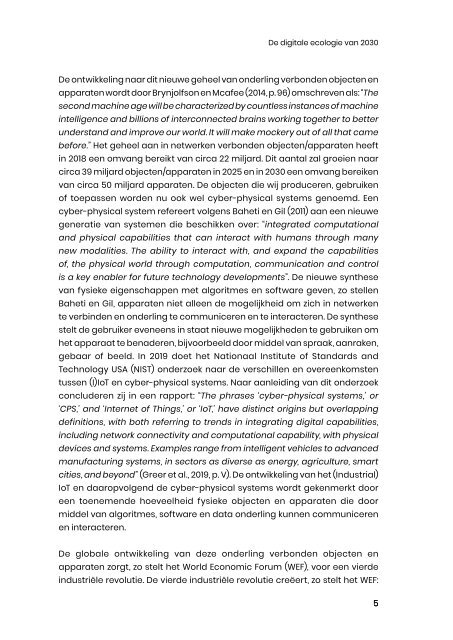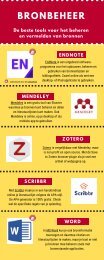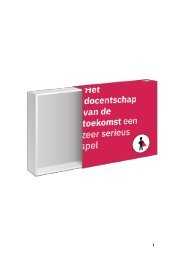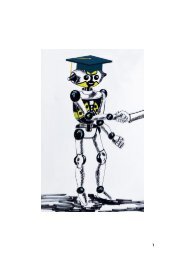De digitale ecologie van 2030
- No tags were found...
Create successful ePaper yourself
Turn your PDF publications into a flip-book with our unique Google optimized e-Paper software.
<strong>De</strong> <strong>digitale</strong> <strong>ecologie</strong> <strong>van</strong> <strong>2030</strong><br />
<strong>De</strong> ontwikkeling naar dit nieuwe geheel <strong>van</strong> onderling verbonden objecten en<br />
apparaten wordt door Brynjolfson en Mcafee (2014, p. 96) omschreven als: “The<br />
second machine age will be characterized by countless instances of machine<br />
intelligence and billions of interconnected brains working together to better<br />
understand and improve our world. It will make mockery out of all that came<br />
before.” Het geheel aan in netwerken verbonden objecten/apparaten heeft<br />
in 2018 een om<strong>van</strong>g bereikt <strong>van</strong> circa 22 miljard. Dit aantal zal groeien naar<br />
circa 39 miljard objecten/apparaten in 2025 en in <strong>2030</strong> een om<strong>van</strong>g bereiken<br />
<strong>van</strong> circa 50 miljard apparaten. <strong>De</strong> objecten die wij produceren, gebruiken<br />
of toepassen worden nu ook wel cyber-physical systems genoemd. Een<br />
cyber-physical system refereert volgens Baheti en Gil (2011) aan een nieuwe<br />
generatie <strong>van</strong> systemen die beschikken over: “integrated computational<br />
and physical capabilities that can interact with humans through many<br />
new modalities. The ability to interact with, and expand the capabilities<br />
of, the physical world through computation, communication and control<br />
is a key enabler for future technology developments”. <strong>De</strong> nieuwe synthese<br />
<strong>van</strong> fysieke eigenschappen met algoritmes en software geven, zo stellen<br />
Baheti en Gil, apparaten niet alleen de mogelijkheid om zich in netwerken<br />
te verbinden en onderling te communiceren en te interacteren. <strong>De</strong> synthese<br />
stelt de gebruiker eveneens in staat nieuwe mogelijkheden te gebruiken om<br />
het apparaat te benaderen, bijvoorbeeld door middel <strong>van</strong> spraak, aanraken,<br />
gebaar of beeld. In 2019 doet het Nationaal Institute of Standards and<br />
Technology USA (NIST) onderzoek naar de verschillen en overeenkomsten<br />
tussen (I)IoT en cyber-physical systems. Naar aanleiding <strong>van</strong> dit onderzoek<br />
concluderen zij in een rapport: “The phrases ‘cyber-physical systems,’ or<br />
‘CPS,’ and ‘Internet of Things,’ or ‘IoT,’ have distinct origins but overlapping<br />
definitions, with both referring to trends in integrating digital capabilities,<br />
including network connectivity and computational capability, with physical<br />
devices and systems. Examples range from intelligent vehicles to ad<strong>van</strong>ced<br />
manufacturing systems, in sectors as diverse as energy, agriculture, smart<br />
cities, and beyond” (Greer et al., 2019, p. V). <strong>De</strong> ontwikkeling <strong>van</strong> het (Industrial)<br />
IoT en daaropvolgend de cyber-physical systems wordt gekenmerkt door<br />
een toenemende hoeveelheid fysieke objecten en apparaten die door<br />
middel <strong>van</strong> algoritmes, software en data onderling kunnen communiceren<br />
en interacteren.<br />
<strong>De</strong> globale ontwikkeling <strong>van</strong> deze onderling verbonden objecten en<br />
apparaten zorgt, zo stelt het World Economic Forum (WEF), voor een vierde<br />
industriële revolutie. <strong>De</strong> vierde industriële revolutie creëert, zo stelt het WEF:<br />
5


















